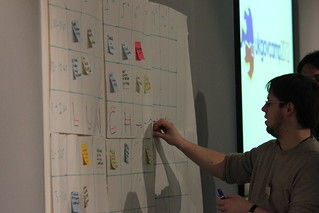In this economy, employers have to be inventive and diligent in order to improve productivity without also increasing overhead costs. While that is easy to type, implicating new programs are difficult and time-consuming. However, with a little elbow grease and some hard-earned respect, every employer can achieve his or her performance goals company wide.

Create a Clever Schedule

Image via Flickr by Ann Kempster
Every person has a unique rhythm at work that leaves them dragging after heavy meals and resolving issues at a full throttle speed mid-morning. Whatever the individual’s job duties, each employee should be encouraged to make a personal schedule that places the most important tasks at the times of highest enthusiasm, energy, and clarity.
By sending a company-wide email with permission to adjust schedules (pending immediate supervisory approval) and an example of your own take on this idea, everyone will get the idea. Get creative. If you have a sudden burst of energy at four PM then you should save a heavy task for that time of day.
Work Like Clockwork

Image via Flickr by wwarby
Each morning employees should make a task list for the day at hand, ordering the items in descending importance. When workers start to tackle tasks they should be encouraged to do incrementally. By setting a timer for a set duration (30 to 90 minutes is recommended), employees can gauge their own productivity: furthermore, having this sort of measure encourages individuals to push themselves.
Get this idea rolling by sending out a memo to teammates with an attached timer. Provide one example, such as that ORSYP workload automation and job scheduling tasks should be assigned a thirty-minute duration. Then, consider handing out five-minute-break coupons as a funny reward for those who are using the system.
Get Off the Grid

Image via Flickr by stevendepolo
While responding to emails is important, and answering phone calls might be in your job description, both of these tasks are a huge distraction for a focused mind. Whenever possible each employee should be allowed to ignore communication (with impunity) for large blocks of time. The average employee will check emails 36 times an hour at work; that time waste doesn’t account for the lost transition time back to projects from each email (16 minutes).
Free your workers to be more productive. For example, if a worker needs to focus on design for infographics without distraction, he or she might be permitted a four-hour response time during business hours. Coordinate each employee’s offline time with supervisors.
Understand Pareto’s Principle

Image via Flickr by toolstop
Pareto’s Principle basically states that 20% of your work will clear 80% of your plate. What does that mean for office productivity? If you encourage employees to focus on daunting tasks first, they will feel the pressure ease when those tasks are completed. The remaining tasks will go by much more quickly when dread of difficult tasks is alleviated.
By employing these four great strategies you will find your workers are happier, more rested, and of course more productive. In addition to these four ideas, remember that everyone should always be permitted to say no if their workload is too intense: this last key will keep everyone on an honest schedule for success.










Comments